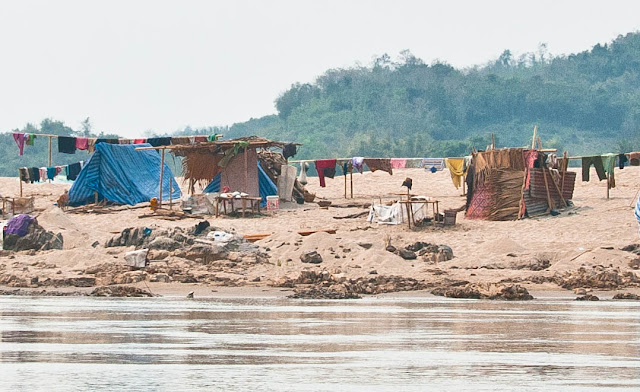
The booklet turned out to be extremely accurate and we could anticipate each potential campsite. This was the site of our first camp. Our second day saw us enter Lake Laberge, something like 50kms long.
Conditions were mostly calm and it was 2 and a half days of paddling along the east shore until we were back in the flow of the river.
.

It doesn't take long to become aware of the rich history of this area. Glimpses of old log structures dating back to the late 19th century are not rare. Pilings used by the paddle wheelers that came up the Yukon river from the Pacific bringing supplies were also common along the shoreline.
They would tie up at wood yards where fuel was loaded for their steam engines.
.

Eventually the lake ended and the water began moving again. The next couple of days were noted for the lively clip of our canoe along this part of the river as well as the beautiful clarity of the water.

As you can see from this last picture some of the campsites were complete with picnic tables, firepits and even outhouses at some. We were surprised by the infrastructure we found all along the river. It seems that paddling the Yukon is one of the territory's premier attraction's. We encountered individuals and groups with and without guides every day. Thankfully there were plenty of campsites for all.

The Five Finger Rapids have an ominous reputation. Upon reading and talking to locals we were able to deduce that most of the deadly passages through the rapids occurred during spring run off over 100 years ago, usually with poorly built unmaneuverable log rafts manned by inexperienced miners. These granite pillars standing up in the middle of the river constitute the fingers and the rivers splits around them. Our literature suggested to navigate through the extreme east opening and we passed through with ease. The many hours we needed to discuss this passage will not be chronicled here.

With a huge sigh of relief we relaxed to enjoy our surroundings more and the wilderness of the north seeped into our soul.

This area grew from the discovery of gold in the Klondike valley. True wilderness went in every direction for many hundreds and even thousands of kilometers. The only routes through the mountains and bushland were the rivers. Log rafts and homemade boats and eventually paddlewheelers during the short warmer months. Dogsleds and horses on the frozen rivers during the long winters. As more miners and entrepreneurs came to try their living in this climate a wagon road began to stretch along the river shore.
 .
. 
Here, at a place originally called McKay's Crossing, a cable ferry and log hotel was built to offer comfort to the travelers on the tough trip between Dawson City and Whitehorse. The wagon road shortened the trip between the 2 communities by some 160kms by cutting between the bends of the winding river. We can only imagine what the word "comfort" might shore have meant at the time.
As we floated further north we felt civilization slipping behind us. We saw many moose, bear and mountain goats. We began to wild camp to avoid the possibility of other canoe paddlers setting up a camp beside us and disturbing our peace.

There's only one day we can recall a cold rainy morning which forced us to get off of the river and find shelter from the wind. Every other day showed us the best of the Yukon.
This is a trip we can recommend to all levels of paddlers. The river has only a couple of small bumpy spots and the river speed and strength is never difficult to handle. Most paddlers fly into Whitehorse and rent a canoe from one of several outfitters in Whitehorse who will provide pick up service at your chosen take out point. This is a trip being done by many visitors to Canada from all over the world as well as folks from the entire country. We expected a remote solitary experience in the "far north" but we have not seen a more popular river yet anywhere in the world! That being said we have to admit it's popularity is deserved.





















































